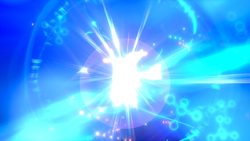Evolution: Difference between revisions
Mr. Daikon (talk | contribs) |
(→Methods of evolution: this list of unique triggers will just expand as evolution methods get weirder (as they've been doing) so best to keep it on the main article for these) |
||
| Line 121: | Line 121: | ||
*{{cat|Pokémon that evolve through trading|Being traded}} | *{{cat|Pokémon that evolve through trading|Being traded}} | ||
Before [[Generation VIII]], the above were the only triggers to evolve Pokémon. However, | Before [[Generation VIII]], the above were the only triggers to evolve Pokémon. However, Generation VIII introduced several new triggers, each used either by a single Pokémon species or by two. | ||
In addition to the trigger, many Pokémon have one or more additional requirements for them to be able to evolve. These include: | In addition to the trigger, many Pokémon have one or more additional requirements for them to be able to evolve. These include: | ||
Revision as of 23:20, 6 February 2022
- If you were looking for the set in the video game Pokémon Trading Card Game, see Evolution (TCG GB1). For the expansion of the Pokémon Trading Card Game, see Evolutions (TCG).
Evolution (Japanese: 進化 evolution) is a process in which a Pokémon changes into a different species of Pokémon.
With respect to real-world phenomena, Pokémon evolution is more similar to metamorphosis than evolution. Evolution is mostly independent from the aging process, instead being triggered by external factors, such as gaining experience in battle or being exposed to certain items.
Evolution is not a merely visual change, as Pokémon of a higher evolutionary stage have different (and usually increased) stats, can learn different moves, and sometimes change types (although normally at least one of the pre-evolved form's types remains the same). Pokémon may also change Ability upon evolution.
Professor Elm and Professor Rowan are the leading experts in Pokémon evolution. According to Elm's research, over 90% of all Pokémon are connected to at least one other through evolution. (Currently, the actual percentage is 80%.) Rowan's research focuses on whether evolution is a form of maturity in Pokémon, and looking at the implications of the process on Legendary Pokémon (which could not evolve in Generation IV, when Rowan debuted).
Evolutionary families
An evolution family is a group of Pokémon who are all related by evolution. The species at the lowest evolutionary stage in an evolutionary family can ultimately evolve into any member of the evolutionary family.
Evolutionary stages
Pokémon evolutionary families have anywhere between one and three stages. In a one-stage family, there is only a single Pokémon that cannot evolve. In a two-stage family, any member of the family can evolve at most once, from the unevolved form into one of the evolved forms. In a three-stage family, at least one of the evolved forms can evolve once again.
In the Pokémon Trading Card Game, Pokémon are divided into four different categories: Baby Pokémon, Basic Pokémon, Stage 1 Pokémon, and Stage 2 Pokémon. Pre-evolved forms introduced in a later generation than their evolved form are classified as Baby Pokémon so that the evolution stages of their evolved forms are not disrupted.
One-evolution families
These are evolutionary families in which a Pokémon can only ever evolve once. These are the most common type of evolutionary families. An example of this type of evolution family is below.
| |||||||||||
Two-evolution families
These are evolutionary families in which a Pokémon can evolve twice. All starter Pokémon, except Pikachu (in Pokémon Yellow) and Eevee, have this type of evolutionary family. An example of this type of evolution family is below.
| |||||||||||||||||
Pokémon that do not evolve
These are evolutionary families with a single member, which cannot evolve. Many of the Pokémon that have no evolutionary relatives are Legendary or Mythical Pokémon, although there are some Legendary and Mythical Pokémon that can evolve.
| |||||||||
Branched evolution families
- Main article: List of Pokémon with branched evolutions
Several one- and two-evolution families are also branched evolution families. A branched evolution family has a member that can evolve into one of several different Pokémon. Eevee is the most extreme example, having eight different possible evolved forms. An example of this type of evolution family is below.
| |||||||||||||||||||
Methods of evolution
- Main article: Methods of evolution
In the core series games, Pokémon normally only evolve after one of three events:
- Gaining a level (the most common trigger)
- Being exposed to an item (such as an Evolution stone)
- Being traded
Before Generation VIII, the above were the only triggers to evolve Pokémon. However, Generation VIII introduced several new triggers, each used either by a single Pokémon species or by two.
In addition to the trigger, many Pokémon have one or more additional requirements for them to be able to evolve. These include:
- Having high friendship
- Holding a specific item
- The time of day
- Knowing a certain move or a move of a certain type
- The location the player is in, or the current weather in that location
- Having a certain Pokémon in the party, or a certain type of Pokémon
- Being upside-down
- Being traded for a specific Pokémon
- Completing the main story, then heading to Luminous Cave after talking to Whiscash, if the Pokémon's requirements are met (Pokémon Mystery Dungeon: Red Rescue Team and Blue Rescue Team)
Some evolutions are dependent on the Pokémon's gender. For example, only female Combee can evolve into Vespiquen—male Combee cannot evolve at all. Similarly, all Snorunt can evolve into Glalie, but only female Snorunt can evolve into Froslass. On the other hand, male Burmy can only evolve into Mothim, while female Burmy can only evolve into Wormadam.
For some evolutions into Pokémon with multiple forms, the form of the evolved Pokémon depends on how it evolved. For example, Wormadam's cloak depends on the cloak Burmy had when it evolved. Similarly, the form of Toxtricity which Toxel evolves into depends on its nature.
In the core series
When a Pokémon evolves, it becomes a new species of Pokémon. This new species has a different Pokédex number and base stats, and may be a different type, learn different moves, and have a different Ability. The Pokémon's personal properties, however, such as Nature and Shininess, remain.
Holding an Everstone prevents a Pokémon from evolving by level up or trade. Additionally, the player can prevent a Pokémon from evolving upon leveling up by pressing the B button when it would evolve. In Pokémon FireRed and LeafGreen, if the player does not have the National Pokédex, if a Pokémon in the Kanto Pokédex meets its evolution conditions but its evolved form is not in the Kanto Pokédex (for example, Chansey's evolution into Blissey), it will attempt to evolve but fail.
When a Pokémon evolves, it immediately attempts to learn all moves that the evolved form can learn at its current level. Additionally, starting in Generation VII, some Pokémon have Evolution moves, which are moves that Pokémon will always attempt to learn when evolving into that species, regardless of level.
Abilities
Normally, a Pokémon will retain its Ability slot upon evolution (i.e. if it had its species second Ability before evolving, it will still have its species second Ability after evolving).
However, some Pokémon originally from the Generation III games can change Ability slot upon evolution. When Abilities were introduced in Generation III, some Pokémon only had one possible Ability but were given a second Ability in Generation IV. If a Pokémon whose species gained an Ability after Generation III is transferred to a Generation IV or V game, it will initially retain its original Ability; upon evolving, however, its Ability slot will be recalculated and its Ability may change. When a Pokémon is transferred to Generation VI or Generation VII, however, it will be locked into the appropriate slot for its current Ability.
Animations
In Pokémon Sun, Moon, Ultra Sun, and Ultra Moon, evolution into an Alolan has a different theme and a different colored background during evolution.

|
This section is incomplete. Please feel free to edit this section to add missing information and complete it. Reason: Gen V should not be a crop |
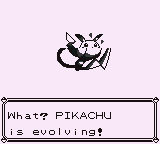
|
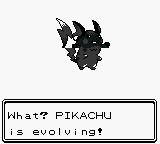
|
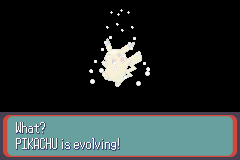
|
| Generation I | Generation II | RS |
|---|---|---|
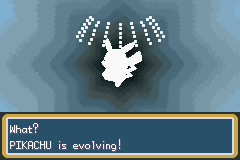
|
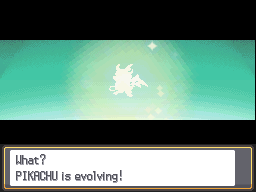
|

|
| FRLGE | Generation IV | Generation V |

|
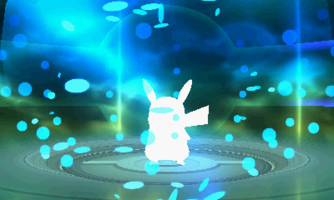
|
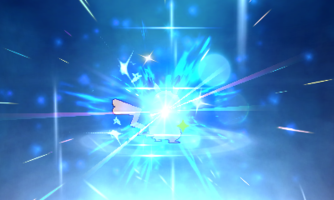
|
| XY | ORAS | SMUSUM |
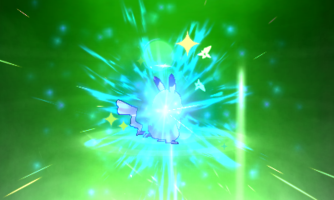
|
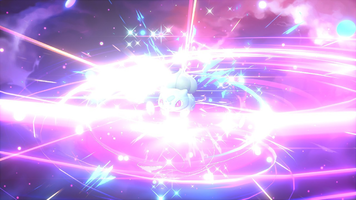
|
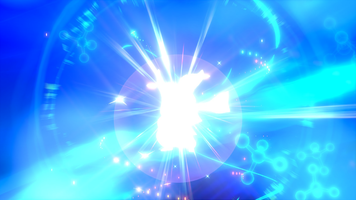
|
| SMUSUM (Alolan Forms) |
PE | SwSh |
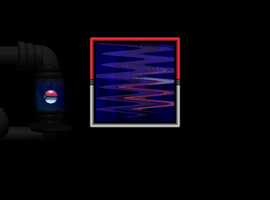
|
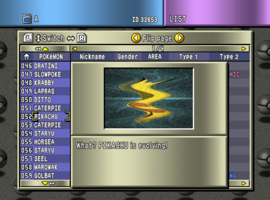
|
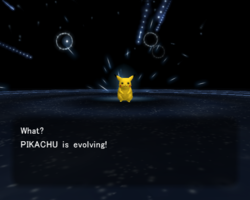
|
| Stadium | Stadium 2 | Colosseum |
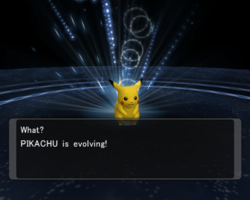
| ||
| XD |
In spin-off games
Hey You, Pikachu!
Some missions in Hey You, Pikachu! involve Pikachu interacting with other Pokémon in certain ways to cause their evolution. In Caring for Caterpie, the player and Pikachu supervise a group of Caterpie, who will evolve into Metapod and then Butterfree if treated well. In Field Trip, Pikachu can water wild Oddish and Gloom, causing them to evolve into Gloom and Vileplume, respectively.
Pokémon Stadium and Pokémon Stadium 2
Pokémon on a Game Boy or Game Boy Color game can evolve in Pokémon Stadium or Pokémon Stadium 2 by fulfilling the conditions required for evolution, such as using an Evolution stone, trading a Pokémon, or using Rare Candy to level up a Pokémon to the required evolution, as in the main series. This can be done in White City's Laboratory. However, items cannot be used to evolve Pokémon in Pokémon Stadium, as level up evolutions are ignored, and evolution stones are not visible in the item list when selecting an item to use on a Pokémon.
Pokémon Colosseum and XD: Gale of Darkness
In Pokémon Colosseum and XD: Gale of Darkness, while evolution typically works as normal in the main series, Shadow Pokémon are incapable of evolving until they are purified and return to normal.
In Pokémon XD: Gale of Darkness, because the game does not have a time mechanic, the player's Eevee cannot evolve into Espeon or Umbreon through the same means as the core series games. Early in the game, the player can choose one of five Evolution items, each of which will cause Eevee to evolve into a different Pokémon. Among these items are the exclusive Sun Shard and Moon Shard, Key Items that allow Eevee to evolve into Espeon or Umbreon, respectively, after it levels up with high friendship.
Pokémon Conquest
In Pokémon Conquest, because the mechanics of levels, experience, and friendship do not exist, Pokémon typically evolve once they reach a certain link threshold with their partnered Warrior or Warlord. Pokémon that normally evolve via high friendship in the main series games, such as Golbat, instead evolve after reaching a certain link percentage, usually between 60 and 70 percent. Pokémon that normally evolve starting at a specific level instead evolve when a certain statistic reaches a specific value. For example, Spheal evolves when its HP has reached a value of 138, which is partially determined by the link with its Warrior. Warriors with Pokémon that require an Evolution stone to evolve must equip themselves with that item and then perform an action that causes their link to improve, such as completing a battle.
Pokémon Pinball series
In Pokémon Pinball and Pokémon Pinball: Ruby & Sapphire, once the Evolution Mode or Evo Mode starts and the player chooses a Pokémon to evolve, then three instances of the same Evolution Item appear somewhere on the table, one at a time. The player is required to get the three repeated Evolution Items before the time runs up to evolve the chosen Pokémon. For instance, if the player attempts to evolve a Vulpix into Ninetales, they will be required to find three Fire Stones on the table. Most available Pokémon evolve by experience, which requires getting three "Ex" Evolution Items. If the Pokémon evolves by trade in the core series, then the player needs to get three Link Cable Evolution Items.
Additionally, the manual of Pokémon Pinball refers to the act of upgrading a Poké Ball (for instance, changing a Great Ball into an Ultra Ball) as "evolving" the Ball.
Pokémon Mystery Dungeon series
Evolution does not occur automatically; instead, it must be manually triggered. Evolution is explained in Story Mode as an effect of the world being in a state of danger. The ability of Pokémon to evolve must be unlocked through the course of Story Mode (in Blue Rescue Team and Red Rescue Team, Rayquaza must be defeated, while in Explorers of Time and Explorers of Darkness, the Wigglytuff's Guild must be defeated). Similarly, in both Gates to Infinity and Super PMD players can evolve after both completing the game and reuniting the main character and partner. In Pokémon Mystery Dungeon Blue/Red Rescue Team evolution does not instantly make a Pokémon stronger, unlike in the core series games; however, as of Explorers of Time/Darkness/Sky, evolution does immediately increase stats.
Starting with Pokémon Mystery Dungeon: Gates to Infinity, Enemy Pokémon will also be able to evolve and will do so if they defeat one of the player's party Pokémon. This is a very old feature that has been present in non-Pokémon entries in the Mystery Dungeon franchise for a very long time (in one sense, it goes back to the very first game in the Mystery Dungeon franchise, though it worked slightly differently there). The sound effect that is used for Enemy Pokémon evolving after defeating a party Pokémon is the same one used in other Mystery Dungeon games for the aforementioned long-standing equivalent mechanic.
Super Pokémon Mystery Dungeon was the first Generation VI game in the series and thus features Mega Evolution. It is achieved by attaching an Awakening Emera onto a Looplet.
Evolution locations
In the Mystery Dungeon series, evolution is usually restricted until reaching the location where evolution is taking place. Evolution is typically done in a ritual held in several locations across the Pokémon world. Pokémon who evolve through unusual methods require an additional item to act as a catalyst.
In Red Rescue Team and Blue Rescue Team, evolution is held in Luminous Cave and will get rid of any additional experience points but will not reduce the level.
In Explorers of Time and Explorers of Darkness and Explorers of Sky, evolution is held in Luminous Spring. The player character and their partner may not evolve until they complete an additional scenario.
In Pokémon Mystery Dungeon (WiiWare) and Gates to Infinity, Pokémon can evolve as soon as they meet the conditions. Due to the fact there is no special location to trigger evolution, evolution not based on items will happen similarly to core series, one attempt per level-up. Enemy Pokémon may evolve after defeating a member of the player's party.
In Super Mystery Dungeon, evolution is held in Tree of Life, with all but level requirements being removed (with the player being given choice for split evolutions). The player and their partner temporarily evolve into their final forms several times throughout the story. In addition, connectable Pokémon that exist as NPCs in this game and previous games will refuse evolution. However, because all Pokémon can be recruited separately through the Connection Orb, the player can still access their respective evolved forms in alternate ways. Certain enemies may evolve in specific conditions.
Evolution items
Because of the different mechanics of Pokémon evolution, certain evolutions have been modified to require particular items:
- Pokémon that must be traded in order to evolve instead require the Link Cable.
- Feebas requires the Beauty Scarf to evolve into Milotic.
- Pokémon that require high friendship to evolve instead require that their IQ be sufficiently high (which differs among Pokémon).
- Magneton and Nosepass require the Coronet Rock to evolve into Magnezone and Probopass, respectively.
- Pokémon that evolve in the daytime instead require the Sun Ribbon.
- Pokémon that evolve at night instead require the Lunar Ribbon.
- Eevee requires a Mossy Rock to evolve into Leafeon or an Icy Rock to evolve into Glaceon.
- In Super Pokémon Mystery Dungeon, evolutionary items do not exist, and Pokémon that usually require these items to evolve will not need them and be able to evolve regardless.
- In Pokémon Mystery Dungeon: Rescue Team DX, evolutionary items have been replaced with Evolution Crystals, which are used for any Pokémon with an evolutionary requirement besides leveling up.
Pokémon Snap
In Pokémon Snap, the player can interact with Pokémon in certain ways that will make them evolve.
- At the end of Pokémon Island's Tunnel stage, if the player lures the three Magnemite together, they will fuse and become a Magneton.
- At the end of Volcano stage, if the player knocks a Charmeleon into the crater of magma it is circling, it will evolve and come out as a Charizard.
- Luring a Slowpoke to a fishing area along the River will prompt it to fish with its tail, hooking a Shellder, causing it to evolve into Slowbro.
- Hitting the Grimer in the Cave three times with Pester Balls will cause it to evolve into Muk.
- In the Valley, completing a series of events will cause a Magikarp to evolve into Gyarados.
Pokémon GO
In Pokémon GO, the player can evolve Pokémon by spending Candy. The Candy cost for evolution varies between Pokémon species, ranging from 12 (to evolve Caterpie into Metapod) to 400 (to evolve Magikarp into Gyarados or Meltan into Melmetal).
- See also: List of Pokémon by evolution family (GO)
In addition to Candy, some Pokémon have additional requirements to evolve. These additional requirements include:
- Random evolution — For some Pokémon with multiple evolutions, the one it will evolve into is determined at random. These include:
- Item requirements
- Introduced with Generation II:
 Sun Stone,
Sun Stone,  Metal Coat,
Metal Coat,  King's Rock,
King's Rock,  Upgrade,
Upgrade,  Dragon Scale
Dragon Scale - Introduced with Generation IV:
 Sinnoh Stone
Sinnoh Stone - Introduced with Generation V:
 Unova Stone
Unova Stone
- Introduced with Generation II:
- IV requirements
- Tyrogue evolves into Hitmonlee, Hitmonchan, or Hitmontop if its highest IV is for Attack, Defense, or HP, respectively.
- Buddy Pokémon requirements — Some Pokémon require players to complete certain activities with it as their Buddy Pokémon to evolve. These may include:
- Gender requirements — Some evolution paths are only possible if the Pokémon is of a specific gender. These requirements are the same in Pokémon GO as they are in the core series.
- Lure Module requirements — Some Pokémon require players to be in range of a special type of lure to evolve. These include:
- Trade Evolution — Some Pokémon will cost zero Candy to evolve if it has been traded
- Nicknames — If Eevee has a particular nickname, then once per nickname, it is guaranteed to evolve into the following, regardless of other conditions:
Pokémon Duel
In Pokémon Duel, before a figure can evolve, the player must own both the pre-evolved figure and the evolved figure. The pre-evolved Pokémon must be set in the deck, and the evolved Pokémon must be set as that figure's evolution. During a duel, the pre-evolved Pokémon will be able to evolve when it wins a battle and either knocks out or displaces its battle opponent. Pokémon can also be evolved by the effects of Attacks, Abilities, and Plates. An evolved figure (including Mega Evolution) will receive +10 to its White and Gold Attacks and +1 ★ to its Purple Attacks. This boost stacks for a Pokémon that has evolved more than once.
In the anime

In the anime, Evolution happens in much the same way as it does in the games; though level-based evolutions and trade-based evolutions do not occur using those methods, there are similarities in the way they come about. For example, Misty's Poliwhirl evolved into Politoed because it found Ash's King's Rock and was holding it when Misty sent it out, while in the games it is required that Poliwhirl be traded while holding the King's Rock for the evolution to take place (it should be noted that Poliwhirl had been through a machine in connection with it being healed at the Pokémon Center while holding the item). When a Beedrill attacked Ash's Metapod, it caused a crack to appear on its shell, which Butterfree came out of (although later examples of Metapod evolving into Butterfree were treated as the more familiar form of evolution used in the anime).
Additionally, a difference can be seen in the fact that Pokémon evolve during a battle, as opposed to after it. Pokémon may also evolve when they are needed to, for an extra boost of power or gaining new abilities, instead of after a set amount of training, such as when Ash's Charmeleon evolved into Charizard to battle an Aerodactyl just three episodes after it evolved from Charmander, where the game requires Charmeleon to grow twenty levels to reach that stage. In addition, Pokémon can sometimes choose not to evolve, even if they evolve by a 'natural' method such as leveling up. This was shown when Ash's Bulbasaur refused to evolve during an evolution festival for all Bulbasaur to evolve in Bulbasaur's Mysterious Garden. It appears that Evolution has emotional implications for Pokémon - some Pokémon, such as Team Rocket's Meowth, dislike their evolved forms, while others such as Ash's Pikachu simply want to prove they can be powerful without evolving. Conversely, when Pokémon do evolve, this can often be linked with an experience that causes them to mature emotionally or deal with an emotional issue, such as when the Poochyena in A Bite to Remember evolved, or the Paras in The Problem With Paras. Poochyena, for some reason, had an aversion to using the move Bite, while Paras was extremely timid and weak in battle. Both of them evolved shortly after overcoming these issues. In Enter Pikachu!, it was revealed that Ash's Pikachu evolved from a Pichu in the wild during a silent, tearful parting with a pack of Kangaskhan that had acted as his surrogate family.
When a Pokémon begins to evolve, it will be enveloped by a brightly-colored light while slowly changing form; in the original series, Pokémon the Series: Ruby and Sapphire, and Pokémon the Series: Diamond and Pearl, the light is simply white in color while in Pokémon the Series: Black & White and Pokémon the Series: XY, the light is blue in color. In Pokémon the Series: Sun & Moon, different evolution effects were introduced depending on which Pokémon is evolving; for instance, when Mallow's Bounsweet evolved into Steenee, it shined pink and the physical changes that came with the evolution could be seen happening. Although some Pokémon returned to the old-style evolution effect (for instance, Sandygast into Palossand and Mareanie into Toxapex), others have been seen with completely new effects (notably Rockruff and Litten).
For a list of all evolutions that Pokémon belonging to the main cast have undergone, see List of anime Pokémon by evolution.
In the manga
Evolution is portrayed differently across manga adaptations. For example, in Pokémon Pocket Monsters, Pokémon are capable to evolve whenever they wish, and they revert to previous evolution stages. It seems that Pokémon can skip evolution stages as well, as is the case with Green's Charmander when it skips its Charmeleon stage and evolves directly into Charizard.
In the TCG
Evolution in the Pokémon Trading Card Game is very similar in some aspects to its counterpart in the core series. However, it differs mostly in the fact that there are no different methods needed to evolve a Pokémon, but instead, all Pokémon evolve simply by placing the next stage on top of a Pokémon in play that it evolves into.
Normally, Pokémon cannot be evolved on the first turn of the game or the first turn they come into play, as well evolve on the same turn they have previously evolved or devolved.
Stages of evolution
There are three main stages of evolution in the TCG along with its variants:
- Basic Pokémon, which represent the most basic evolutionary stage. Pokémon that evolve from a Pokémon released in a later generation, such as Electabuzz or Pikachu, are usually Basic Pokémon, despite being the second Pokémon in their evolutionary lines;
- Stage 1 Pokémon, which represent the middle or final evolutionary forms of certain Pokémon and is the basic stage of Fossil Pokémon in some sets;
- Stage 2 Pokémon, which represent the final evolutionary forms of certain Pokémon.
Only Baby Pokémon and Basic Pokémon may be placed onto the Bench during the setup phase and during play; other Pokémon are considered to be evolution cards and therefore unable to be played except on top of their corresponding pre-evolved forms. The stage of evolution is indicated in a conspicuous place on every Pokémon card, though the placement differs among the generations of cards.
Pokémon cards that evolve from others as stated on the card are referred to as Evolution cards or Evolution Pokémon. Evolved Pokémon are Pokémon that were put into play by evolving a Pokémon in play.
Ability to evolve
A Pokémon card that is in the player's hand must say specifically that it evolves from a Pokémon card that is in play on the player's side. For example, Dark Blastoise states on the card "Evolves from Dark Wartortle". This means that any card named Dark Wartortle may be evolved into Dark Blastoise. However, a card simply named Wartortle cannot. Likewise, Pokémon such as Rhyhorn cannot be evolved into a Pokémon that says on it "Evolves from Team Magma's Rhyhorn".
However, Pokémon cards from different sets may evolve into one another. For example, Dark Crobat can evolve from either Dark Golbat of the Team Rocket set or Dark Golbat of the EX Team Rocket Returns set. So long as the card names match precisely both to (here Dark Crobat) and from (here Dark Golbat), the evolution is legal. This rule, of course, can be circumvented by certain means, such as Pokémon Powers and Trainer cards, however, this is not common.
In relation to the real world
Evolution in Pokémon is closer to the real-life phenomenon of metamorphosis rather than actual evolution, as real-life evolution happens to populations over a long period of time, not to individuals. In the Pokémon Adventures manga, it is mentioned that Pokémon Evolution is an entirely separate phenomenon from the normal process of evolution, and is a mysterious ability exclusive to Pokémon that is still not fully understood. In Pokémon Super Mystery Dungeon, it is described in the health class at the school in Serene Village as when a Pokémon's body rapidly grows larger with many other changes bringing a Pokémon closer to being an adult, being described akin to puberty.
Trivia
- Of all non-Legendary and non-Mythical Pokémon, 90.87% are part of an evolutionary line.
- Counting Legendary and Mythical Pokémon, 84.19% of all Pokémon are part of an evolutionary line.
- Out of all Pokémon that evolve by leveling up, Larvesta evolves later than any other unevolved Pokémon, starting at level 59.
- Of all the Pokémon that evolve by leveling up, Hydreigon evolves from its pre-evolution later than any other Pokémon, starting at level 64.
- Since no leveling up is required to evolve either Porygon or Porygon2, Porygon-Z is the only Pokémon to be evolved twice that can still be level 1.
- Generation III introduced the most non-Legendary and non-Mythical Pokémon that do not evolve, with 18.
In other languages
| |||||||||||||||||||||||||||||||||||||||||||||||||||||||||||||||||||||||||
See also
References
| Pokémon training | |
|---|---|
| Catching • Nicknaming • Battling • Evolving • Trading • Breeding • Releasing | |
